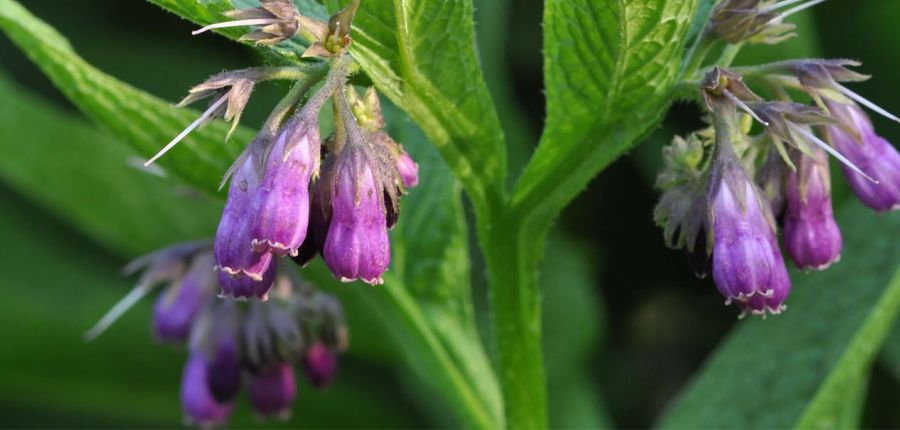The benefits of Comfrey
Posted By: rocket veg Category: Plant Care, Seasonal AdviceYesterday I cut my comfrey for the third time this year. Like most plants, comfrey benefitted from the long warm spell we enjoyed and put on a real growth spurt. Comfrey is a plant with extraordinary properties. Classed as a perennial herb it’s happy growing in a damp, grassy corner and from early spring onwards and produces a clump of large leaves which are covered with tiny, tough hairs. The pretty blue or white bell-shaped flowers, carried on a bristly stem, are much loved by bees which crawl inside in search of nectar.
Our native comfrey, Symphytum officinale, is widespread across the British Isles and over the years, has also crossed with other varieties to produce a form known as S. x uplandicum which tends to be more bristly with flowers a deeper purplish blue. Once established, comfrey is difficult to remove, its strong root system ensuring the plant returns year in, year out. Although it seems reluctant to spread, left to grow unchecked, the leaves and flowering stems will droop and fall over neighbouring plants, effectively blocking out light and preventing growth. Getting rid of unwanted comfrey involves digging out the root – a tricky business as the tip of the main root lies deep in the ground and nearly always breaks off, only to regrow. In the plant world, comfrey is an impressive survivor.
The benefits of comfrey
So why grow this thug of a plant? Well, comfrey brings a number of major benefits to the garden or allotment. The root system reaches deep into the subsoil in search of nutrients - nitrogen, phosphorus and potassium in particular - which then feed and are stored in the developing leaf system. The good news is that comfrey is very forgiving and can be cut to the ground a couple to times each year, the leaves and stems then be put to good use, as follows.
Uses of comfrey
As liquid feed: there are various ways to produce this nitrogen-rich liquid which forms the basis for an excellent and free plant feed. Either pack comfrey leaves into a suitable container which has a tap or hole in its base, cover to exclude light, place in a sunny spot and wait for a few weeks for the leaves to rot and the deep brown juice to flow. It’s strong stuff, so will need to be diluted before use. Or, simply soak a bundle of comfrey leaves in rainwater, again in a covered container, to produce ‘comfrey tea’ which is ready for use – all very satisfying. At the end of the year, the rotting matter left when the liquid has been drawn off can be tipped onto the compost heap.
As compost accelerant: include layers of comfrey leaves in your compost heap. As the leaves break down, the nitrogen which is stored in them helps to heat the heap and speed up the overall rotting time. Advice says not to add too thick a layer of comfrey as it is likely to form a sludgy mass which will need turning into the other matter in the heap.
As top dressing and mulch: grab a bunch of comfrey leaves (avoid using the stems), give them a twist and squeeze before placing them around the stems of plants which either need a nutrient boost or will benefit from a mulch. Applied this way, comfrey will work best for crops which need extra potassium, such as potatoes – some veg gardeners who I know plant seed potatoes on a bed of comfrey leaves to boost initial growth. Comfrey leaves are also reckoned to boost the production of soft fruit plants and bushes.
How to grow comfrey
If you are convinced about the benefits of comfrey and have the space to grow some plants – in a forgotten corner of the garden, or along the front of your allotment plot perhaps - buy a packet of comfrey seed and follow the instructions. Or better still, ask someone who has a large number of comfrey plants if they can spare one – dig up the long root, cut into chunks and pop a bit into a deep hole where you want a plant to grow. It really is that easy.
And finally…
Beware - contact with comfrey bristles may cause a nasty, itchy rash, which happened to me a few summers ago when I harvested comfrey on a sunny day - an example of ‘photosensitivity’ where the combination of strong sun and plant sap can affect the skin. Apart from the initial irritation, I suffered no serious effects and have harvested comfrey numerous times since without a recurrence.







